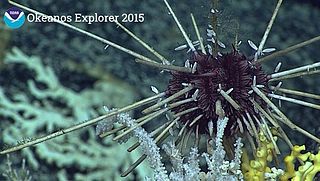
Astropecten is a genus of sea stars of the family Astropectinidae.

Coelopleurus is an extant genus of echinoids with fossil records dating back to the Eocene, with remains found in Europe and North America.

Arbacioida are an order of sea urchins, consisting of a single family, the Arbaciidae. They are distinguished from other sea urchins by the presence of five separate plates around the anus. Unlike their close relatives, the Salenioida, all of the tubercles on their tests are of similar size.

Cidaridae is a family of sea urchins in the order Cidaroida.

Spatangus is a genus of heart urchins in the Spatangidae family. The genus is synonymous with the previously recognised genera Prospatangus Lambert, 1902 and Spatagus. There are nine recognised species. The type species is Spatangus purpureus Müller, 1776 by subsequent designation.

Clypeaster, common name "cake urchins" or "sea biscuits", is a genus of echinoderms belonging to the family Clypeasteridae.

Eucidaris is a genus of cidaroid sea urchins known as slate pencil urchins. They are characterised by a moderately thick test, a usually monocyclic apical disc, perforate and non-crenulate tubercles and nearly straight ambulacra with horizontal pore pairs. The primary spines are few and widely spaced, stout with blunt flat tips and beaded ornamentation and the secondary spines are short and apressed. They originated in the Miocene and extant members of the genus are found in the tropical Indo-Pacific Ocean, East Pacific, Atlantic Ocean and Caribbean Sea.

Schizaster is a genus of heart urchins belonging to the family Schizasteridae. The type species of the genus is Schizaster studeri.

Histocidaris is a genus of sea urchins in the family Histocidaridae. Some species are known from the fossil record.

Amblypneustes is a genus of sea urchin, belonging to the family Temnopleuridae.

Temnopleuridae is a family of sea urchins in the infraorder Temnopleuridea.

Caenopedina is a genus of sea urchins of the family Pedinidae.
Brissus is a genus of echinoderms belonging to the family Brissidae.
Cassidulus is a genus of echinoderms belonging to the family Cassidulidae.
Phyllacanthus is a genus of echinoderms belonging to the family Cidaridae.
Prionocidaris is a genus of echinoderms belonging to the family Cidaridae.

Stereocidaris is a genus of echinoderms belonging to the family Cidaridae.















